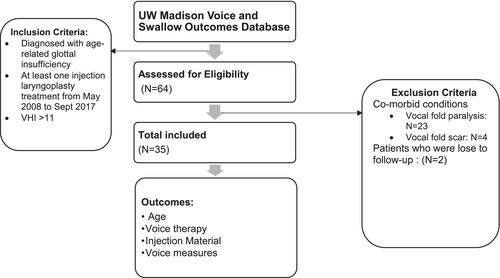Treatment Durability of Injection Augmentation of Vocal Fold Atrophy
Abstract
Objective
Injection augmentation (or injection laryngoplasty) is a common treatment for presbyphonia. As current injection materials are temporary, it is anticipated that patients injected for presbyphonia will either need a repeat injection or framework surgery to maintain glottal competence (or sufficient glottal closure). Despite the expected temporary nature of these injections, patients report variable durability of effect, and some do not require a repeat injection. The primary aim of this investigation was to identify factors that affect treatment durability of injection augmentation among patients with presbyphonia.
Methods
Patients who underwent one or multiple injection augmentations for presbyphonia between May 2008 and September 2017 were extracted from the UW Madison Voice and Swallow Outcomes Database. Variables collected included demographics (age, sex), injection material, volume, duration between injections, date of first and last follow-up, voice therapy (yes/no, number of sessions), and pre- and post-injection voice measures (Maximum Phonation Time, Dysphonia Severity Index, Glottal Function Index score, Vocal Handicap Index Score) in an observational cohort design. For patients receiving one injection (TF group), duration between injection and last follow-up was taken as a durability measure termed “time to follow up.” For patients receiving multiple injections (TR group), duration between injection treatments were termed “time to reinjection.” Patients receiving one or more injections were compared separately and together (where treatment durabilityTF+TR refers to the combined TF + TR group) in different statistical analyses.
Results
Thirty-five patients with presbyphonia met inclusion criteria (mean age 74.3 years [SD 7.6], 78% male). Twenty patients received only one injection. Repeat injection augmentation was performed in 40% of patients (n = 15, ranging from 1 to 6 additional injection augmentations). Maximum phonation time increased after injection augmentation (or injection laryngoplasty) and was similar across injection materials (HA (mean change (SD)): +6 s (3) [95% CI 0.1–0.8], CaHa: +4 s (2.8) [95% CI 0.2–0.7], p < 0.001). Treatment durabilityTF+TR was longer for hyaluronic acid injectables when compared to calcium hydroxyapatite injectables (1232 days [CI: 552–1911] vs. 257 days [168–345], χ2(2) = 7.505, p = 0.023). Voice therapy extended treatment durability TF+TR for injection augmentation compared to no voice therapy (1388 [95% CI: 772–2003] vs. 277 days [206–349 days], χ2(1) = 9.173, p = 0.002). Age did not affect treatment durability TF+TR (χ2(1) = 1.01, p = 0.67).
Conclusion
Factors that affected treatment durability TF+TR for injection augmentation treatments were the type of injectable and whether patients underwent adjuvant voice therapy.
Level of Evidence
III, Retrospective cohort study.


 求助内容:
求助内容: 应助结果提醒方式:
应助结果提醒方式:


